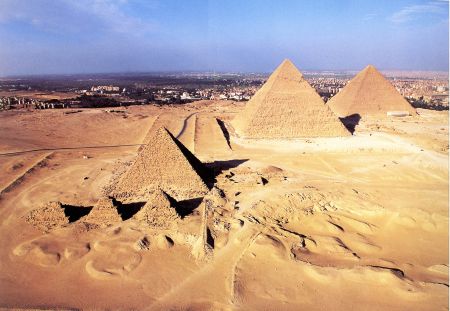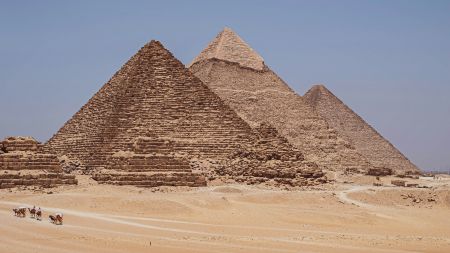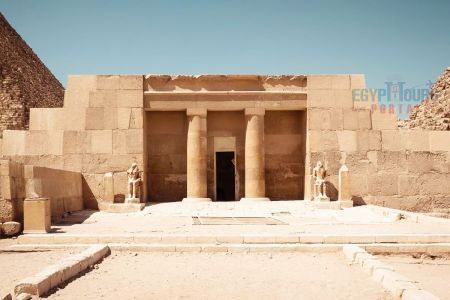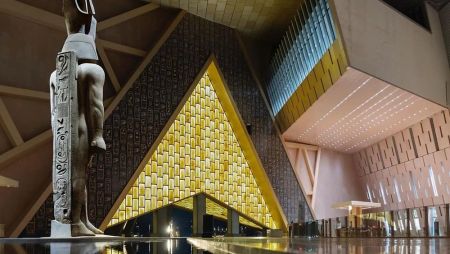The Great Sphinx of Giza: Guardian of Egypt’s Ancient Mysteries

Towering silently on the Giza Plateau, the Great Sphinx of Giza is one of the world’s most iconic monuments. With the body of a lion and the head of a human, this colossal limestone statue has stood guard at the edge of the desert for more than 4,500 years. Facing directly east, the Sphinx greets the rising sun each morning, embodying both the power of the pharaoh and the mysteries of ancient Egyptian civilization.
Measuring over 73 meters long and 20 meters high, the Great Sphinx is not only the largest monolithic statue in the world but also one of the most enigmatic. Scholars debate who built it, what it symbolizes, and why it was carved in such a monumental form. While most historians attribute its construction to Pharaoh Khafre of the Fourth Dynasty (c. 2558–2532 BC), alternative theories range from older origins to celestial alignments with the stars and solstices.
For centuries, the Sphinx lay buried under the sands of time, leaving only its head visible. Today, after extensive excavations and restorations, visitors can marvel at its full grandeur, standing against the backdrop of the Pyramids of Giza. The Great Sphinx of Giza is more than a monument; it is a timeless guardian, a symbol of ancient wisdom, and a riddle carved in stone that continues to captivate the imagination of the world.
The Great Sphinx of Giza – An Introduction to Egypt’s Oldest Guardian
The Great Sphinx of Giza in Egypt is believed to have been built during the reign of Pharaoh Khafre, around 2500 BC. Carved from a single mass of limestone directly from the Giza bedrock, the statue represents strength, wisdom, and divine kingship. Its leonine body symbolizes power and dominance, while the human face, likely modeled on Khafre himself, reflects intelligence and authority.
Unlike the pyramids, which served as tombs, the Great Sphinx had a more symbolic and spiritual role. Positioned along the approach to Khafre’s pyramid and valley temple, the Sphinx acted as a guardian of the necropolis, warding off spiritual dangers and protecting the pharaoh’s eternal resting place.
Historical Origins and Construction of the Great Sphinx
Pharaoh Khafre’s Legacy
Most Egyptologists agree that the Great Sphinx was carved during Khafre’s reign in the Fourth Dynasty. Its alignment with Khafre’s pyramid complex and the architectural connection with his valley temple strongly support this theory. The craftsmanship also matches the style and scale of other Fourth Dynasty works.
Carving and Techniques
The statue was sculpted directly from limestone bedrock using copper chisels and stone hammers. The extracted blocks were repurposed for nearby temples. Evidence suggests the builders began with the head and worked backward, leaving the body in proportion to the natural shape of the bedrock.
Restoration Efforts in Antiquity
The earliest known restoration dates back to Thutmose IV (1401–1391 BC), who erected the famous Dream Stele between the Sphinx’s paws. According to the inscription, Thutmose fell asleep beneath the Sphinx, and the deity appeared in a dream, promising him kingship if he cleared the sands engulfing the statue. This stele marks one of the earliest examples of conservation in history.
Symbolism and Meaning of the Great Sphinx
The Dual Nature of the Sphinx
The Sphinx combines the body of a lion—symbol of strength and guardianship—with the head of a man, representing intelligence and divine kingship. This union embodied the pharaoh as both a powerful ruler and a wise protector.
Solar Alignment and Worship
Facing east, the Sphinx aligns with the rising sun, linking it to the solar cult of Ra. Many scholars believe it functioned as a cosmic symbol of rebirth, connecting the pharaoh to divine forces of the sun.
Alternative Theories
Some alternative researchers suggest the Sphinx predates Khafre, citing erosion patterns that may indicate water damage from heavy rainfall thousands of years earlier. Others link its construction to advanced lost civilizations or celestial alignments with Orion and Leo. While mainstream archaeology remains cautious, these theories add to the Sphinx’s allure as an eternal riddle.
Architectural Features of the Great Sphinx of Giza
Dimensions and Structure
-
Length: 73 meters (240 feet)
-
Height: 20 meters (66 feet)
-
Head: 4 meters wide, adorned with a royal nemes headdress
-
Paws: Extend over 15 meters forward
-
Material: Natural limestone bedrock
Missing Nose and Beard
The most noticeable damage is the missing nose, which measures over one meter wide. Popular myths blame Napoleon’s soldiers, but sketches from centuries earlier confirm the nose was missing long before. Fragments of the Sphinx’s ceremonial beard were discovered and are now displayed in the British Museum and Cairo Museum.
Surrounding Structures
The Sphinx is flanked by temples built from blocks quarried during its construction. These structures, often overlooked by visitors, include the Sphinx Temple and Khafre’s Valley Temple, both showcasing remarkable Old Kingdom engineering.
Rediscovery and Excavation of the Great Sphinx
For centuries, the Sphinx was buried beneath desert sands up to its neck. Only its enigmatic head peered above the dunes. The first modern excavation began in the early 1800s under Giovanni Battista Caviglia. Later, French archaeologist Auguste Mariette and Egyptian scholars continued the clearing.
In the 20th century, comprehensive excavations revealed the full body, paving stones, and surrounding temples. Restoration projects by Egypt’s Supreme Council of Antiquities continue today, preserving the statue against erosion and pollution.
Visiting the Great Sphinx of Giza Today
Location and Access
The Sphinx lies on the Giza Plateau, adjacent to the Great Pyramid and Khafre’s pyramid. It’s easily accessible from Cairo, just 30 minutes away by car.
-
Opening Hours: 8 AM – 5 PM (longer during peak season)
-
Tickets: Entry included with Giza Plateau admission
-
Best Time to Visit: Sunrise or sunset for dramatic lighting
Experiences and Tours
Many guided tours include the Sphinx as part of a Giza Plateau package, often combining the pyramids, the Solar Boat Museum, and panoramic desert views. Nighttime visitors can also attend the Sound and Light Show, where the Sphinx narrates stories of ancient Egypt through an immersive audiovisual performance.
AIDA Breakdown for the Great Sphinx of Giza
Attention
A colossal guardian carved in stone, half-lion and half-human, staring across the desert for 4,500 years.
Interest
The Great Sphinx of Giza isn’t just the world’s largest monolithic statue—it’s a symbol of divine kingship, ancient mysteries, and forgotten legends.
Desire
Imagine standing at its massive paws, where pharaohs once prayed for power and where dreams were said to foretell kingship. The aura is both humbling and awe-inspiring.
Action
Don’t just admire it in photos—visit the Great Sphinx of Giza and witness one of humanity’s most extraordinary achievements with your own eyes.
Frequently Asked Questions About the Great Sphinx of Giza
1. Who built the Great Sphinx of Giza?
Most Egyptologists believe Pharaoh Khafre of the Fourth Dynasty built the Sphinx around 2500 BC.
2. What does the Great Sphinx represent?
It symbolizes strength, wisdom, and divine kingship, blending a lion’s body with a human head.
3. Why is the nose of the Sphinx missing?
The nose was destroyed in antiquity, long before Napoleon’s time. The exact cause remains unknown.
4. How old is the Great Sphinx?
Mainstream archaeology dates it to 2500 BC, though alternative theories suggest it may be older.
5. Can you go inside the Great Sphinx?
No. While there are small tunnels and chambers beneath, they are closed to the public.
6. What is the Dream Stele of the Sphinx?
An inscription placed by Thutmose IV between the paws, recording his dream that led to kingship.
7. Is the Great Sphinx open at night?
Yes, visitors can attend the evening Sound and Light Show at the Giza Plateau.
Final Thoughts
The Great Sphinx of Giza remains a timeless wonder—guardian of the pyramids, embodiment of royal power, and enigma carved in stone. Its colossal presence has inspired pharaohs, mystics, scholars, and travelers alike for thousands of years. Standing before it today, you can feel the weight of history pressing from every angle. Whether seen at dawn bathed in golden light, or under the stars during the night show, the Sphinx whispers of forgotten ages and eternal mysteries.








